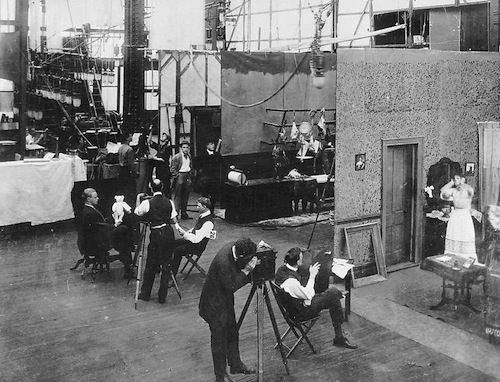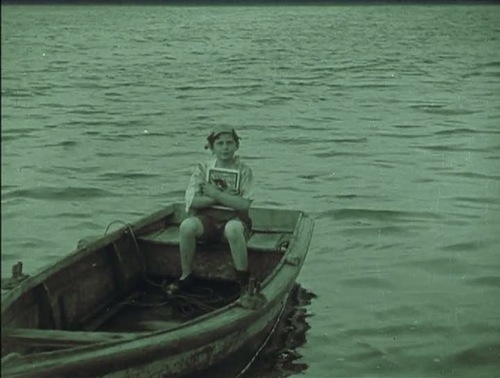The Fantasy and Science Fiction Films of Thomas Edison

In the annals of early silent film, the name Thomas Edison stands out prominently. The American inventor racked up a series of firsts–building the first film studio in the U.S., registering the first copyright for a film in the U.S., making the first sound film in the U.S. (and arguably the world), and many other innovations.
Edison Studios was launched in 1894 and ran until 1918, when an antitrust lawsuit led Edison to sell the company. In that time, the studio’s host of directors made almost 1300 films. The vast majority were shorts, with the earliest efforts being “actualities” such as The Sneeze (1894) and the historically interesting Sioux Ghost Dance (1894). For the first few years of film, simply seeing people moving on screen was enough, but soon audiences wanted stories. Edison Studios churned out dozens of shorts a month, most of them rather forgettable comedies or dramas as well as a few Westerns such as the very first in the genre, The Great Train Robbery (1903).
A few, however, broke new ground in fantasy, science fiction, and horror. The most notable are The Night Before Christmas (1905), Alice’s Adventures in Wonderland (1910), A Christmas Carol (1910), Frankenstein (1910), A Trip to Mars (1910), and the powerful The Land Beyond the Sunset (1912). Click the links to watch the movies. None are longer than 13 minutes. Spoilers are coming.

The Night Before Christmas may be Edison’s first foray into fantasy. It opens with Santa feeding his reindeer and packing his bags for a long night’s work. A few lines from the famous poem are used for intertitles and there are some simple special effects, including stop motion animation of Santa’s sleigh (somewhat crude even for 1905) and a jump cut technique to make a Christmas tree and presents appear in a lucky household.
Film adaptations of famous stories were popular, and Edison filmed an early version of Alice’s Adventures in Wonderland in 1910, although I haven’t been able to track this one down. Several films online claiming to be Edison’s film are actually the 1903 version from the UK. Edison’s 1910 A Christmas Carol closely follows Dickens’ text and makes effective use of transparent overlay to have a series of ghosts put Scrooge through his paces.
Edison Studio’s most enduring adaptation of a story was the first filming of Frankenstein in 1910. There’s a memorable scene of Frankenstein creating his monster in a smoky vat. It appears bit by bit, and I think this special effect was done by burning a mannequin and then reversing the film. Frankenstein then abandons his creation and goes home to get married, only for the monster to follow him. The monster sees itself in the mirror and his horrified, and his creator turns him out of the house.
Then, on Frankenstein’s wedding night, the monster reappears and slips into the bride’s room. There’s an effective use of tension where the bride and the monster are off screen for 13 seconds (ages in a movie) before she comes running into the arms of her groom. Once again the monster flees, sees itself in the mirror, is horrified by his own image, and disappears. The reflection remains, however, and as Frankenstein comes up to the mirror he sees the monster’s reflection instead of his own, before the image fades and he sees himself in the mirror. Heavy-handed symbolism to be sure!

A still from A Trip to Mars (1910)
A Trip to Mars (1910) opens with a scientist discovering “reverse gravity” and then having a few splitscreen adventures on the Red Planet. This had all been done better eight years earlier by Georges Melies in his A Trip to the Moon. It’s still a fun little film to watch, though.
One of Edison Studio’s most effective films is only marginally fantasy. The Land Beyond the Sunset was filmed in collaboration with the Fresh Air Fund, a charity that takes inner-city kids on trips into the countryside. The film opens with Joe, a ragged newspaper boy trying to sell his papers and having no luck. He even faces the camera and tries to sell one to us, but we don’t help either. He lives with his abusive grandmother who steals his pitiful earnings for drink.
Joe does have some luck, however, because the Fresh Air Fund invites him out for a day in the country. There are games and a picnic and a walk through the woods and fields with a view of the ocean. It’s Joe’s first sight of the world beyond the slums.
All the kids gather together to listen to one of the teachers read from a book a fairy tales. Joe is captivated by the story of a boy escaping a wicked witch with the help of fairies, who put him on a boat to sail to The Land Beyond the Sunset where he will always be happy. The story is filmed with Joe as the boy and the grandmother as the witch. There are only a few special effects, but the fantasy element is there, especially in Joe’s mind.
Then it’s time to go back to the slums. Joe is downcast, and slips away from the rest. Walking alone along the beach, he comes across a rowboat. There are no oars, but the boat in the fairy tale didn’t need them since it was guided by the fairies. Dreaming of the tale he’s heard and clutching the book, he casts off and sails off towards the horizon. It’s a moving ending, and of course can be read two very different ways. I wonder what the Fresh Air Fund thought of it.

I have not been able to see all of Edison Studio’s films and there may be a few more genre films among the mix. If you know of any, please share them in the comments section.
If you like silent film, you might like my posts on silent fantasy masters Walter Booth and Segundo de Chomón, and one on real outlaws in silent Westerns.
Sean McLachlan is a freelance travel and history writer. He is the author of the historical fantasy novel A Fine Likeness, set in Civil War Missouri with Jesse James as a supporting character, and the post-apocalyptic thriller Radio Hope. His historical fantasy novella The Quintessence of Absence, was published by Black Gate. Find out more about him on his blog and Amazon author’s page.
All images are in the public domain.
[…] The Fantasy and Science Fiction Films of Thomas Edison – Black Gate […]